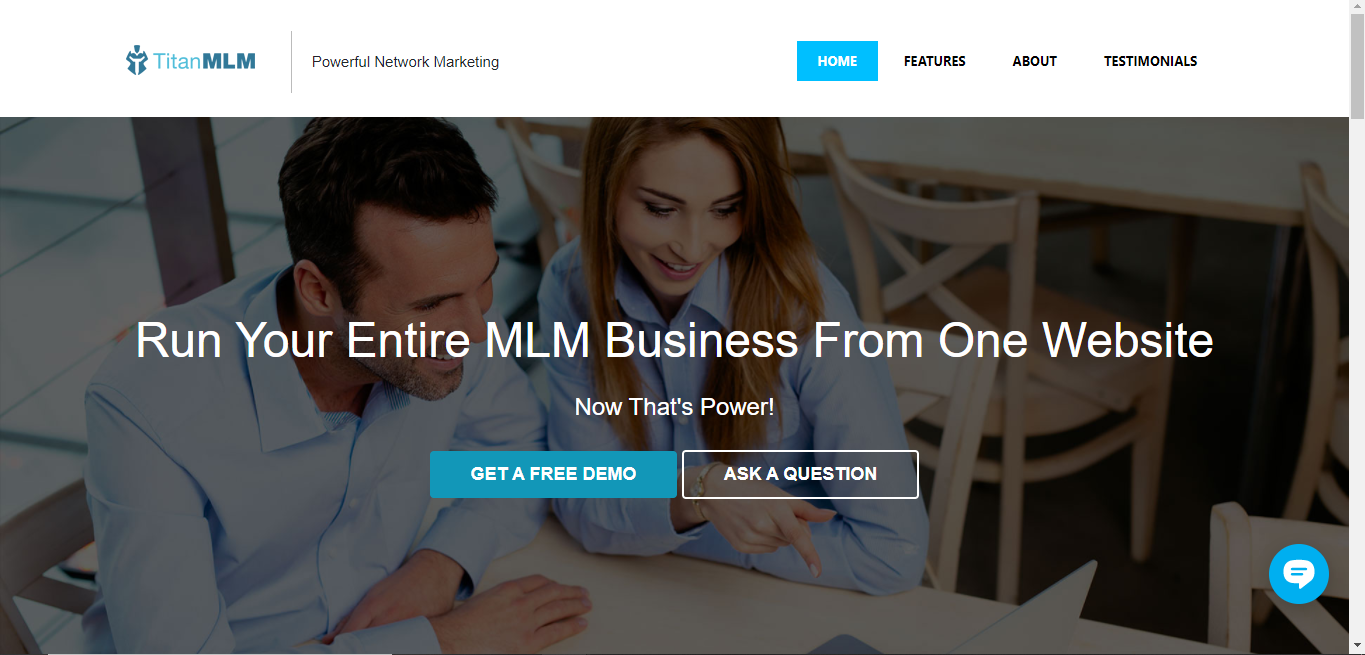
Landing pages are the best way to drive traffic and get conversions.
Let me put it a different way: You need a web page for visitors that is direct, to the point, and convinces them to take action and become your customer. Essentially, a landing page is a simple storefront on the web.
A landing page is specifically created for that purpose: to gain more customers.
What exactly is a landing page?
A landing page is the web page that a visitor will “land on” or arrive at after they’ve clicked on a link. This link could be in a paid ad (such as Facebook or Google Adwords), a link from social media posts, a link on a search engine result page (called a SERP by us marketers), or any other link out there.
Now, a dedicated landing page is the kind that converts the best. This is an entire page created to sell one particular action. The action could be purchasing a product, requesting a quote, or joining your mailing list. In the example below, our
TitanMLM Landing Page is asking visitors to contact us, either by Asking a Question or Requesting a Demo.
Why do you need a landing page?
Dedicated landing pages make the most of your marketing efforts. They are targeted, and give the visitor to your page exactly what they wanted when they clicked on your ad, post, email, etc.
If you really want to increase your customers online, a landing page is the key to success. Most landing page software (like our MarketingWebsite.com) includes other marketing automation features, like email autoresponders, that will really increase the conversion rate of your subscriber list.
Depending on organic (unpaid) traffic from Google can be risky, as search algorithms are constantly changing and if you're not ranked at the top for search, it is unlikely you'll get clicks from searchers. Landing pages are built to optimize paid traffic from paid advertising, such as Google Adwords or Facebook ads, or other marketing campaigns like email or social media.
If you want to really make the most of your online marketing, landing pages are a crucial part of your strategy.
How does a landing page work?
The process is simple:
1. You create an ad about your product through Google Adwords, Facebook Ads or anywhere else.
2. Someone searching for your type of business or product sees the ad and clicks on your ad.
3. They are taken to your landing page.
4. They read the persuasive content and fill out the form.
5. Your landing page sends a follow up email.
6. You can also send them future promotional emails.
7. They might click on the link in the email.
8. They come back to your landing page (or a different landing page), and make another purchase.
9. You now have a lifetime customer that you can continue to sell to, over and over again.
That is how a successful landing page works. If you have more than one product, you probably will want more than one landing page.
How to create a landing page that sells:
1. Have a clear call to action.
The first thing visitors should see when they land on your page is YOU TELLING THEM WHAT THEY SHOULD DO NEXT.
Sign up for our free trial now!
Save money on your insurance today!
Buy now and save!
These are all compelling call to actions that are telling the visitor what to do. Visitors like that. They don’t want to search for a form or wonder how or when to purchase. Tell them. It makes their life much easier.
2. Keep your form simple.
Don’t ask for too much information. People DON’T like that. They want to commit as little as possible. Name and email? Perfect. If you require more from them, consider taking them to a second page where they can continue filling out the remaining information.
They’re already committed, so odds are good that they’ll fill in the rest. Here is a great example of using a hook to grab some info, and then getting the rest later on a second page:
3. Keep your content precise and clear.
Avoid including links to other articles or pages. All your content should be written with your call-to-action in mind. Whether you choose long- or short-form landing page design, every word you use should be selling that form at the top of your page.
Some pages, particularly long form landing pages that include more content, will have multiple places for a visitor to enter their information so they don’t need to scroll around to find a form. The key here is that each form is selling the same thing, using the same type of persuasive content.
In the TitanMLM example, you can see how this long-form landing page has navigation at the top so visitors can jump directly to areas of the page they are interested in:
But you can see here that each section on the page has a form to grab their information:
4. Page Design
Think about what is above the fold.
The "fold" is the area that divides what you see first when you "land" on a page, and what you need to scroll down to see. The most important information, including the call-to-action, should be above the fold. No scrolling should be necessary for them to take action.
Use few images and large fonts.
People get distracted by images, and overwhelmed by too much text. Make their lives easier by getting rid of distractions, and I'll say it again, TELL THEM WHAT YOU WANT THEM TO DO. The focus must be on the clear, concise copy (preferably in larger fonts that are easy to read) and the call-to-action.
Make the page centered and single column.
Studies have shown that single column landing pages convert best. If you think a two-column page is a better fit for your offer, be sure to test it before spending too much money sending traffic to it.
Match the landing page to the ad.
Landing pages that match the ad copy perform better. People click on an ad because they want whatever is being offered, so make sure the offers match once they get to your page. For example, if you have an email campaign to drive traffic to your landing page, use a similar design in both, or copy some of the same wording.
5. Follow Up
The follow up is just as important as the design of the landing page itself. So someone has filled out the form on your landing page, or made a purchase. What next?
Send them emails.
Autoresponder emails have the highest open rates, and this is your chance to upsell them or remind them of your brand.
- Welcome them to your company
- Confirm their purchase while suggesting other items they might like
- Add them to a "drip campaign" that will send them periodic emails automatically, telling them about your product (if they haven't purchased) or upselling them on other items.
Our
MarketingLANDER.com system includes these follow up emails, as well as a complete CRM Contact Manager to edit emails, see who is clicking and opening them, and so much more. These tools are essential to making the most of your dedicated landing pages, and turning leads into sales.
Have you tried landing pages in your marketing? Do you love them, hate them, or have questions? Share in the comments below!
We sell landing pages! If you're interested in trying a dedicated landing page for your business, or just want to learn more, please contact us now.




